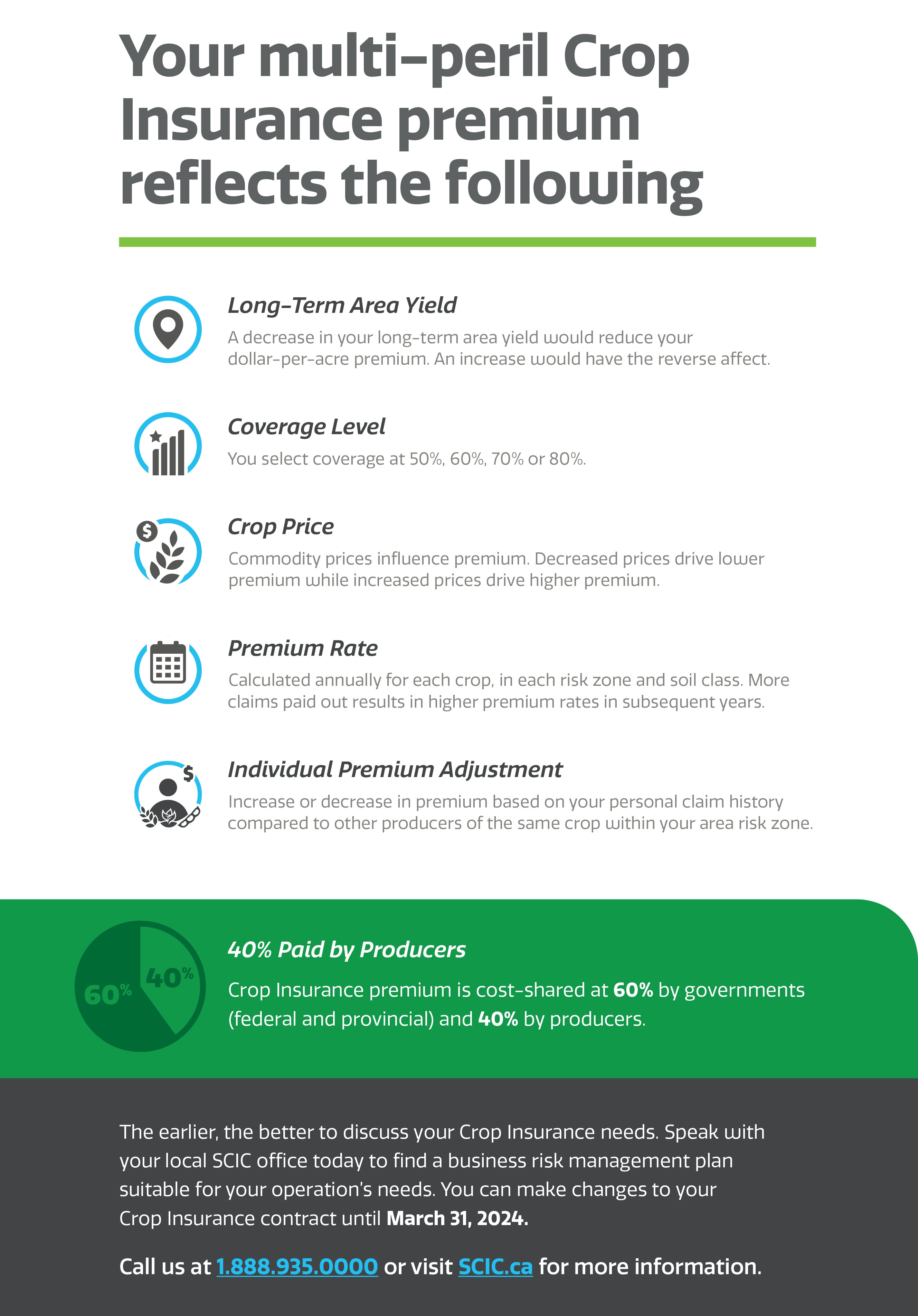What makes up your Crop Insurance premium?
Article written by SCIC
(also available in 2024 Yield Saskatchewan publication presented by The Western Producer)
The Crop Insurance Program continues to respond in times of need. Producers’ coverage and premium are individualized to their operation. Coverage reflects each producer’s production records and premium reflects each producer’s claim history.
There are different pricing options and coverage levels available to best suit the needs of your farm.
To discuss your Crop Insurance options, please contact your local SCIC office, or call toll-free at 1-888-935-0000.
Long-Term Average Yield
For each crop, within each risk zone and soil class, a long-term average yield (the average of all reported yields within the Crop Insurance Program) is used to calculate each producer’s dollar-per-acre premium. This gives every producer the same base for their insurance premiums before applying any other adjustments. The long-term average yield is also used to establish insured coverage for new Crop Insurance customers.
Coverage Level
Each farm is different and each operation’s risk management needs are different. That is why SCIC offers various crop selections and coverage options within the Crop Insurance Program. For most crops, producers can select coverage at 50, 60, 70 or 80 per cent of their average yield, adjusting the total production guarantee. Similarly, your Crop Insurance premium is reflective of your selected coverage level. Naturally, when the level of risk to the Program increases, premium for producers will also increase.
Premium Rate
A premium rate is calculated annually for each crop, in each risk zone and soil class, reflecting a long-term expected loss experience and overall financial position of the Crop Insurance Program. One of the primary components within the premium rate is the claim history in each risk zone. Simply put, the more claims paid out results in higher premium rates in subsequent years. There is a one-year lag in the data (claims from previous years) used to calculate premium rates. A reminder 2022 yields and claims will be used to calculate 2024 coverage and premium.
Other notable components within the premium rate include the costs for SCIC to offer the Establishment Benefit feature and the costs of reinsurance. The Establishment Benefit feature offers coverage for acres that do not grow or adequately establish. As with yield-loss claims, if previous years resulted in a large amount of Establishment Benefit payments, this also increases premium rates. Additionally, SCIC purchases reinsurance to help protect the Crop Insurance Program from the risk of a major claim event.
Crop Price
The base price for most crops is based on Agriculture and Agri-Food Canada’s January price forecast for the upcoming year. Pedigreed, forage and organic crops have a separate price structure to reflect the value of these crops. When an insured price decreases from a previous year, the premium cost also goes down – along with the coverage.
Producers can customize their Crop Insurance by selecting different pricing options. Base price is the default for Crop Insurance multi-peril endorsements. SCIC offers a range of price options, including Low Price, Contract Price and In-Season Price. A select group of crops are also eligible for the Crop Averaging Program.
Individual Premium adjustment
The next factor in determining premium is a producer’s Individual Premium adjustment. This is an increase or decrease from the base premium, calculated individually for each crop you insure. Each producer’s Individual Premium is unique to their own farming operation, based on personal claim history compared to the area risk zone.
Individual Premium allows Crop Insurance to be more responsive to your farming experience. Claims on one crop do not impact premiums for other crops. When you receive your Crop Insurance coverage details, the premium you see is your Individual Premium – inclusive of any premium adjustments (rather than displaying discounts or surcharges separately).
Premium is Cost-Shared
This program continues to be actuarially sound, with premiums set to ensure the long-term sustainability of the program. In addition, premiums are cost shared 60 per cent by federal and provincial governments and 40 per cent by producers. Administration costs are fully funded by provincial and federal dollars.
REMINDER: Premium is only charged on the actual acres seeded and selected to insure. You may endorse all crops during the Crop Insurance enrolment period – if you do not seed all crops, premium is not charged.








